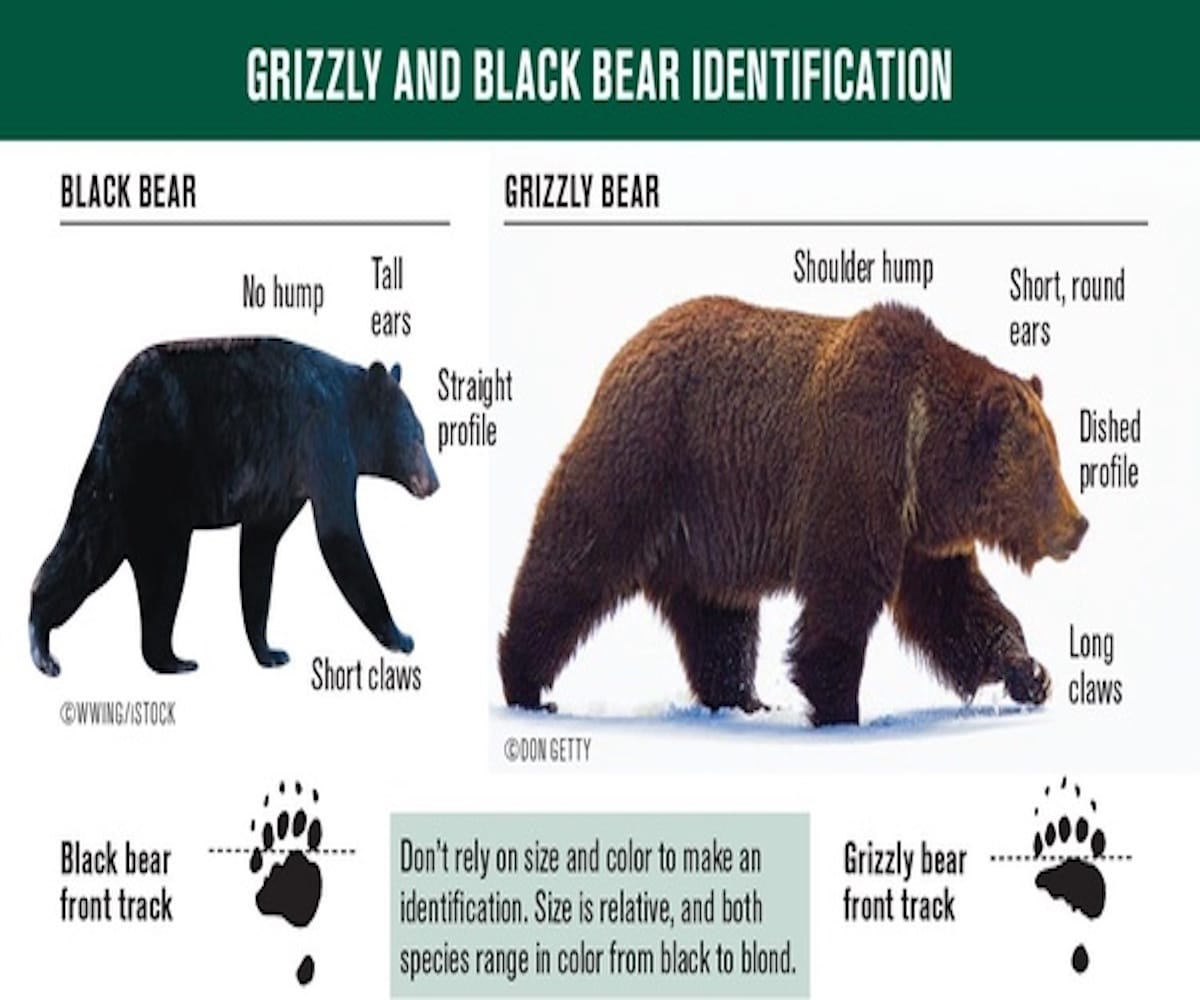Spring has come and with it the bears.
Please be careful when visiting the center and remember to be
Bear Aware!
Here are some tips to keep you safe:
First of all, KNOW YOUR BEARS
:max_bytes(150000):strip_icc():format(webp)/grizzly-bear-56a9b4723df78cf772a9c47e.jpg)
Grizzly Bears
- Color: Range in color from black to light blonde. Mostly medium to dark brown in color. The long hairs usually have a lighter tip; hence, grizzly bears look “grizzled.”
- Size: Average 350-500 lbs. Larger grizzlies can reach 800 lbs!
- Height: Stand around 3.3 ft; 6.5 ft at the shoulder.
- Shape: Look for a distinct shoulder hump.
- Face: There’s a depression between the eyes and end of the nose, and they have short, round ears.
- Claws: Very long (2-4 in)
- Prints: Minimal arc in toes, toe imprints are close together, and the claw leaves long, visible marks.
:max_bytes(150000):strip_icc():format(webp)/black-bear-56a27cc33df78cf772769c18.jpg)
Black Bears
- Color: Range in color from black to light blonde. Many black bears have a lighter patch on their chest, and reddish-colored bears are common in the west.
- Size: Average 110-300 lbs. Large males can reach 400 lbs and be larger than a female grizzly.
- Height: A little smaller, from 2.5-3 ft at the shoulder. Around 5 ft standing.
- Shape: No hump like the grizzly.
- Face: A straight line runs between the forehead and end of the nose. They have larger, pointed ears.
- Claws: Shorter (around 1.5 in)
- Prints: Look for a large toe arc, toe imprints will be futher apart, and the claws usually don’t leave an impression.
Camp and Picnic Area Precautions
When you’re camping at the lodge or picnicking, put away food and other items with strong odors (ie, toothpaste, bug repellent, soap, etc.) out of reach of bears. It’s best to bring these items inside the Lodge.
Change your clothing before you go to sleep or go out for a hike; don’t wear what you cooked in to go to bed or in the woods and be sure to store smelly clothing along with your food and other smelly items.
Keep the camp and picnic area clean. Be sure to wash dishes, dispose of garbage, and wipe down tables. Burn garbage completely in a hot fire and pack trash out – don’t bury it. Be sure to put all trash inside the Lodge at night or when leaving for a hike.
Backcountry and Trail Precautions
Never surprise bears! If you’re hiking, make your presence known. Make noise by talking loudly, singing, or wearing a bell. If you can, travel with a group. Groups are noisier and easier for bears to detect.
Bring bear spray or bear bangers with you and know how to use them. This may be the most important item you pack with you on your adventures.
Keep in mind that bears tend to be more active at dawn and dusk so plan your hikes accordingly. Stay on marked trails and when you’re hiking in bear country, keep an eye out for tracks, scat, digs, and trees that bears have rubbed.
What to Do if You Encounter a Bear
If you encounter a bear, you should try to remain calm and avoid sudden movements. Give the bear plenty of room, allowing it to continue its activities undisturbed. If it changes its behavior, you’re too close, so back away.
If you see a bear but the bear doesn’t see you, detour quickly and quietly. If a bear spots you, try to get its attention while it is still farther away. You want it to know you’re human, so talk in a normal voice and wave your arms. You can throw something onto the ground (like your camera) if the bear pursues you, as it may be distracted by this and allow you to escape. However, you should never feed or throw food to a bear.
Remember that a standing bear is not always a sign of aggression. Many times, bears will stand to get a better view.
What to Do if a Bear Charges
Remember that many bears charge as a bluff. They may run, then veer off or stop abruptly. Stand your ground until the bear stops, then slowly back away. Never run from a bear! They will chase you, and bears can run faster than 30 mph.
Don’t run towards or climb a tree. Black bears and some grizzlies can climb trees, and many bears will be provoked to chase you if they see you climbing.
If you have pepper spray, be sure that you have trained with it before using it during an attack.
What to Do if a Grizzly Bear Attacks
- Play dead!
- Lie face down on the ground with your hands around the back of your neck.
- Stay silent and try not to move.
- Keep your legs spread apart and leave your pack on to protect your back.
- Once the bear backs off, stay quiet and still for as long as you can. Bears will often watch from a distance and come back if they see movement.
What to Do if a Black Bear Attacks
- Be loud, wave your arms, and stand your ground.
- Fight back! Be aggressive and use any object you have.
- If you are sure the bear attacking is a mother who is protecting its cubs, play dead.
- If you have pepper spray, use it. Begin spraying when it’s within 40 ft so it runs into the fog. Aim for the face.
As with all trips, be sure to research where you are going and what wildlife is in the area. Preparation and knowledge are the keys to ensuring a safe trip for you and yours.

